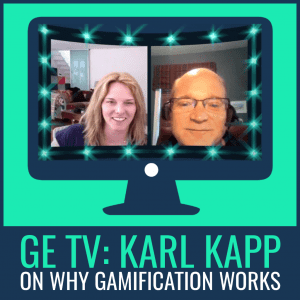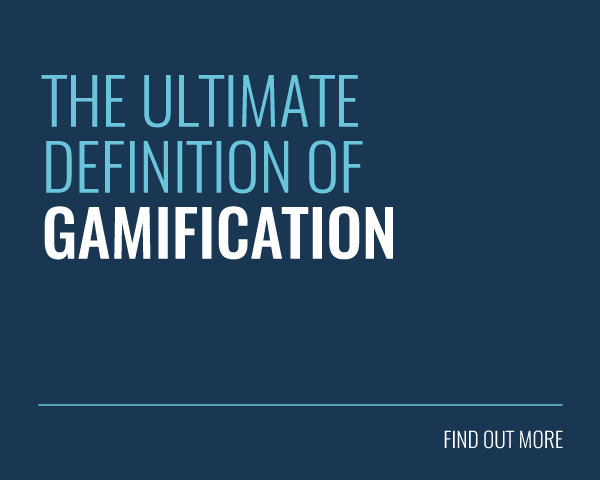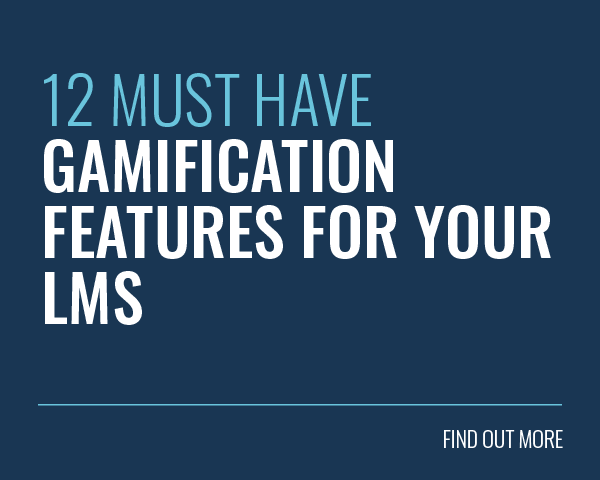 Welcome to a brand new episode of GE TV! This week we’re joined by renowned gamification expert, consultant and professor, Karl Kapp.
Welcome to a brand new episode of GE TV! This week we’re joined by renowned gamification expert, consultant and professor, Karl Kapp.
Karl is a professor and director at Blooomsburg University’s Institute for Interactive Technologies. He’s also the author of a number of must-read books, including ‘The Gamification of Learning and Instruction’ and ‘Gadgets, Games and Gizmos for Learning’.
Just like us here at Growth Engineering, Karl has a burning passion for creating engaging and effective learning experiences. So it’s no surprise that we were eager to sit down with him to find out everything he knows about game-based and gamified learning!
Watch this 20-minute interview to find out:
- Why learning games aren’t just a waste of time
- Why gamification and game-based learning work
- How to deploy gamification and learning games effectively
- Karl’s three core elements for driving learning with gamification
- How gamification can personalise the learner experience
Check below the video for a full transcript.
[vc_video link=”https://www.youtube.com/watch?v=EA9tjIZnfsw”]
[vc_tta_accordion toggle=”1″]
[vc_tta_section title=”Full interview transcript” icon=””]
(0:00) Hi and welcome to GE TV! In this episode, we’re going to talk to the renowned gamification expert, consultant and designer, Karl Kapp.
Now Karl, as I’m sure you know, is a professor and director at Blooomsburg University’s Institute for Interactive Technologies. He’s also the author of a number of must-read books, including ‘The Gamification of Learning and Instruction’ and ‘Gadgets, Games and Gizmos for Learning’.
Just like us here at Growth Engineering, Karl has a burning passion for creating engaging and effective learning experiences, for individuals and organisations.
So Karl, thank you so much for joining us at GE TV!
Thanks Juliette for having me! Really excited to be here, and really excited to be talking about games and gamification.
(0:58) Fantastic! So let’s jump right in. We’ll start with an easy question. How would you respond to claims that video games, or games in general, are a waste of time, and a frivolous activity?
So the first question I would ask is, don’t you think lectures are a waste of time and a frivolous activity?
Lots of times, people think that the ideal learning situation is a classroom lecture, but the research doesn’t support that. In fact, the research is pretty clear that game-based learning can be a really effective way of motivating individuals, helping them retain knowledge, and actually helping them to be more engaged.
There are lots of studies that show that activity is what drives learning. I always think it’s really funny that they hold up the classroom lecture as the gold standard of instruction, yet it’s not as gold standard as you think.
In fact, there’s some research that shows that people in lecture situations actually pay attention to the information at a problem solving or creative level less than 1% of the time.
If we really want creativity and problem solving, and higher-level thinking, we really need to move away from the lecture and move more toward games and game-based learning.
And we certainly feel that we’ve really seen the value of gamification and game-based learning in what we do here at Growth Engineering. The more we seem to put gamification and game-based learning into our clients, the bigger the learner engagement and excitement around the learning becomes. So we’ve certainly seen that.
(2:39) Second question – Why do you think it is that learners, generally speaking, find games much more appealing than more traditional learning approaches?
I think the main reason is kind of what you said. When we as an industry-first put content online, we took the worst part of classroom instruction and automated it.
We had the boring PowerPoints, we had the slides, we had monotone voices, we had no activity, we had no ability to read facial expressions. I always say that we took the humanity out of learning. What games and gamification does is put the humanity back into learning.
I think a big part of it is a rebellion against really boring, ineffective learning. Almost everybody I talk to who watches traditional instruction has checked their email, has looked at their phone, because there’s no level of engagement. Because it’s somebody’s disembodied voice talking to you.
But what really needs to happen is there needs to be some action or activity. People like activity. So that’s what gamification and games do. They add that activity, they add the humanity back in, they add some excitement back in, they add challenge. Humans like challenges, what we’ve done with a lot of instruction is take the challenge out, so games and gamification put the challenge back in.
I think all of those elements contribute towards people really moving towards it.
The other is that people now in corporations grew up playing video games. They are engaged with video games, they have literally the whole world at their fingertip with a cell phone. They can see anything they want, have any kind of activity they want, yet we give them non-interactive instruction. So we can’t compete with the cell phone.
We need to do that, and the good thing about making it interesting and engaging is that leads to learning. People say it’s ‘sugar-coating learning’, but it’s actually how learning occurs.
If you look back at how kids learn, they play. And that’s not different to how adults learn.
Kids will go to school all day, and they’ll come home and playschool. Well, they were just there all day, why? Because they’re reinforcing the rules and the concepts of how school works.
So as adults we need to do that as well, we need to have that play. Because play frees our minds a little bit, it allows us to get into a state of flow, and it allows us to be more open to receiving content and information.
So there’s a lot of value to games and gamification.
(5:18) So within the world of serious games and learning games, obviously there are situations where you’ll have some content which is not that fun. It might be compliance content or content of a very serious nature.
How can you deploy gamification and game-based learning, when the content itself isn’t fun?
That’s a good question. Let me answer in a couple of ways.
Very interestingly, if we look at life and death situations, we look at military, we look at healthcare, those are the areas that have implemented serious games first.
The military has been doing war games forever. If you look at the situation in terms of medical, we have ‘save the patients’ and ‘we can’t let the patient die’. So there are critical things that we use game-based or simulation to do.
So if we look at content, what we want to do is find out what does the learner, the employee needs to do? Whatever they’re doing in their job, maybe it’s very boring or not very interesting, but it does have some consequences somewhere that are going to be interesting or life-threatening or monetarily threatening.
So I think we need to find out where those key intrinsic drivers are, and move the instruction in that direction.
But let’s also look at some elements of games. Maybe the content is boring, but people actually get excited when they master something when they learn something when they see that they’re making progress, when they see that they are levelling up.
So some of those elements which people say ‘who cares about whether or not you get a badge?’ Badges are tangible evidence that you’ve learned something, and if it’s tied well, people like to know that they’ve learned things.
People spend hours by themselves learning certain esoteric things. We all have a friend who knows every historical fact ever. He or she’s not getting paid for it, they just know it. And they love to show that off because they love to show off their knowledge. Can you create environments where people can show off their knowledge, show off their progress?
Also, people love to share. We all have friends, like that history person, who share everything, want that social validation. So we can put them in a situation where they can share their knowledge and show that they’ve gained that knowledge, even if it’s what we call ‘boring knowledge’, it can be really exciting.
Think about trivia, and how many people go to trivia nights at pubs and bars. Trivia’s kinda boring. Who cares about the founder of whatever? But we care because we want to see how we do!
So can we take knowledge like that, but from a corporate where we do care about whether we’re in compliance or whether we fill out the expenditure report correctly, and that other information that’s not really that exciting, and put it into an exciting way of learning it and reflecting upon that learning. I think that’s a good way to look at it.
(8:23) Interesting. So in terms of the higher levels of Bloom’s Taxonomy, in terms of really getting the knowledge to turn into behaviour, what kind of game-based techniques have you seen that work really well to try and really embed solid change, and transform cultures to be more information security cognisant, or to be more health and safety aware, or more financially prudent, or whatever it might be?
I think there’s a couple of things. One is that if you take a step back, we have to have that level of comprehension and declarative knowledge at the basic level. You have to have that, and gamification is a great way to do that.
If we go up, what gamification does better than a lot of traditional instruction is show the consequences of not doing the behaviour. So what gamification can do really well is give you the consequences, and the other thing it does is it adds the emotion back in.
It’s not dry, like ‘don’t do this or you’ll get in trouble’, ‘don’t do this or your password will get hacked’. It’s more like ‘okay, your password’s just been hacked, why do you think that is?’ Or ‘you’ve got to figure out this problem, and you’ve got to do it fast’. Or ‘you’re about to be audited tomorrow, what’s wrong with this expense report?’
That put you immediately into an emotional state if it’s done right, but a controlled emotional state. So you’re not overly panicked, but you know that something is at stake with gamification. Maybe it’s starting over, or not getting as many points.
That element of something at stake makes it more interesting and drives behaviour change.
I always ask people to think of their most effective learning moment ever, and it’s probably due to some kind of emotion. You couldn’t get something, you were frustrated, and then all of a sudden the lightbulb goes off and you’re like ‘I got it!’ You’re gonna remember that a lot longer than ‘here’s the information, you got it, good’.
Gamification adds that element of emotion that ties us into changing our behaviour.
And the other good thing about gamification, in particular, is that it does this over time. This week you get some information, next week you get some information. Studies show that reinforcement over time is really the only way to change behaviour.
I read a really interesting study about people who had a heart attack. 25% of them, this was men, didn’t change their behaviour at all after the heart attack, and other people went back to doing the same thing after a period of time.
Well, it’s because there’s no reminder, there’s no sticking to it. What gamification can do if it’s designed really well is give you a reminder in the form of questions. That’s going to shape behaviour, and in organisations, that’s what we want. We want to shape behaviour to the outcomes we want.
Games give that emotional element, gamification can continue that shaping, and get the behaviour to where we need it to be.
(11:40) Fantastic. You recently mapped out three core elements which you say help drive learning with gamification. Can you briefly talk us through them?
The first is visual measurement of your progress. People in a lot of learning situations don’t know if they’ve gotten the information until way later, at the end when we’ve given them a quiz, or weeks later when they try to apply it.
Gamification is really helpful in that it gives you information that provides you notice of your progress. People like to know that they’ve learned, they like to know that they’ve accomplished something. So the first is visual notification of your progress.
The second is the socialisation of learning. Learning is a really social activity, games are really social activities. But if you’re taking an online module all by yourself at your desk, there’s no socialisation.
Gamification can add that social aspect. ‘Hey, how’d you do on that question?’ And in fact, socialisation actually means the content has legs beyond the learning event. We go to the water cooler, so to speak, and say ‘hey, that was a really tough question, did you get it?’
If we can add social elements to gamification, that’s really effective and can be really helpful.
The third I call small victories. We go to work and it might be a sludge all day, and we don’t know if we’re doing well or making progress or having any kind of impact. If gamification is done correctly we can get small victories.
You play Trivial Pursuit. You can win Trivial Pursuit by knowing all the trivia, but there’s lots of small victories by knowing the answer to a trivia question. That ability to show mastery and have the excitement of knowing something, of learning something, it’s so interesting.
You go back to kids. The first few years, they’re so excited to go to school. They can’t wait to come home and tell you what they’ve learned. Then after a couple of years of our school system they say ‘school was boring.’ ‘What did you do?’ ‘Nothing.’
We make them sit still, we don’t let them socialise (‘Be quiet!’ ‘Don’t talk to you neighbour!’), we don’t give them any progress, you only get tests at mid-quarter and finals, so you have no sense of whether or not you’re learning.
But if you go back to that early time, it’s those small senses of victory that are really exciting. And in learning and development, especially in a corporate space, we want to give people those small victories. Especially because learning and development is no longer that formal process, people are learning informally, and sometimes a learning management system is the best way to get to those people. That can be really helpful.
So those are the three elements: Showing visible progress of where you are, allowing people to have those small victories, and also the socialisation of learning, so people can brag about their learning, ask questions about their learning, gain understanding. Those three things I think are the most important.
(14:58) The other thing you’ve done recently, which we’ve read and loved, is about personalisation. Personalisation at Growth Engineering is a big part of what we do when we talk to companies. We really loved the latest chapter in your book of ‘Using Games and Gamification to Create Personalised Instruction’.
Could you talk to us a little bit about that?
To go back to talking the worst of classroom instruction, we use broadcast instruction, so we broadcast the same message to everybody.
What gamification though allows us to do if it’s well designed is that I can answer some questions and get them right, but you get them wrong. Well probably vice-versa, I get them wrong and you get them right.
What happens is the instruction I’m getting is personalised to me. ‘Karl, here’s your feedback for this, here’s your feedback for that’.
Gamification also allows us to go at our own pace. In a classroom or online learning module, we have to wait for the audio, so we go at a set pace. Gamification asks us questions, allows us to decide how many and what to answer, personalises it to us. Not just to us as learners but to us at the time.
Let’s say I have lots of time today, I can do more of the learning through gamification. But tomorrow I’m really busy, I have back-to-back meetings, I can only do maybe five minutes.
So it really personalises not just to my understanding of the content, going at my own pace. The feedback it gives me, because what I get wrong might be different to what somebody else gets wrong. Even the day-to-day personalisation of allowing me to decide how much learning I want to do today.
It really gives me a lot of flexibility that traditional learning doesn’t provide.
By that feedback, it lets me know how I’m doing right away. It’s like somebody’s standing over my shoulder saying ‘hey Karl, you got that one right, try the next level’. It gives me that sense of personalisation, but it also gives me the ability to go and do what I want.
Some good platforms even let me go where I want. ‘I already know this, let me try something that I don’t know.’ ‘Let me try a really hard level. Oh, I didn’t do it? Let me come back a level and try that.’
So there are lots of different ways that gamification really adds to personalisation.
(17:25) So exciting! It’s always such a thrill to talk to you Karl, thank you so much for your time, I really appreciate it. There are just so many ideas and I know that if I was working in an organisation you were running, I would just want to learn all the time!
Just finally before you leave, where can people find out more about you and what you do? Because I think everyone should know more about you!
My website is www.karlkapp.com. I’ve got a gamification course on Lynda.com, I’m coming out with a new course in the near future about learning interactively, so that’s an exciting venture.
I’ve got several books. You mentioned before ‘The Gamification of Learning and Instruction’, ‘The Gamification of Learning and Instruction Field Book’, ‘Gadgets, Games and Gizmos’ which was one of my most fun books to write. That was kind of cool.
Those kinds of places. I blog pretty frequently. You can follow me on Twitter @kkapp. I’m always doing links and fun stuff on Twitter as well.
And let me tell you Juliette, I really enjoy what you guys are doing. I think with learning superheroes and Genie and all that kind of cool stuff, really moving gamification ahead in corporations and organisations.
I talk about it sometimes theoretically, it’s nice to see it put into practice, and the really exciting results that you get, so thanks for having me!
Fantastic! Thank you so much and I hope we can do this again soon! Thanks Karl.
Absolutely! Bye!
Be sure to check our Karl’s website, and keep an eye out for plenty more GE TV interviews in the coming weeks!
If you’re looking to develop a learning solution which utilises gamification, social and personalised learning, then you need to build an Engagement Engine! Download our free, interactive workbook to plan out a solution which will keep any learner engaged:









